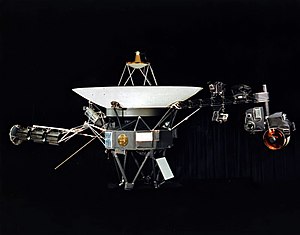
from the New York Times, August 20, 1977
CAPE CANAVERAL, Fla., Aug. 19--The Voyager spacecraft scheduled for launching tomorrow to scout Jupiter, Saturn, and possibly Uranus will be carrying a message from Earth on the off chance that extraterrestrial beings will come upon the craft centuries from now, somewhere on its endless journey beyond the solar system.
The message is in the form of a recoding, called "Sounds of Earth." It is a 12 inch copper phonograph record inserted in an aluminum protective jacket that is attached to the outside of the 1,820 pound spacecraft.
Dr. Carl Sagan, the Cornell University astronomer who conceived the idea, calls the recorded message a "bottle cast into the cosmic ocean."
Languages and Nature

Inscribed on the record are nearly two hours of greetings in dozens of human languages, samples of music of various cultures and times, natural sounds such as the wind and surf and animals and birds, and a message from President Carter.
All preparations were reported to be running smoothly for the launching at 10:25 A.M. tomorrow at the Kennedy Space Center here. The spacecraft, called Voyager 2 even though it is to be the first of the two craft to be launched in the Voyager program, is to
be blasted into its interplanetary course by a Titan 3E Centaur rocket.
George F. Page, the director of the mission launching operations at the space center, said today that "everything is proceeding right on time" and that the forecast was good launching weather.
Voyager2, equipped with television cameras and scientific instruments, is to fly by Jupiter in 1979, Saturn in 1981 and, if all continues to go well, Uranus in 1986. An identical spacecraft, Voyager 1, scheduled for launching Sept. 1, is to explore Jupiter and Saturn. The missions call for the most far-ranging reconnaissance of the outer solar system thus far.
'A Very Big Step'
At a news conference today, Dr. Edward C. Stone, the project scientist from the California Institute of Technology, described the Voyager missions as "a very big step in extending our ability to observe our surroundings and the solar system."
The $400 million project has been five years in preparation, directed for the National Aeronautics and Space Administration by the Jet Propulsion Laboratory of Pasadena, Calif. The idea of attaching a phonograph message to the space vehicle was an afterthought.
The messages on the record were designed to enable possible extraterrestrial civilizations that might intercept the spacecraft millions of years hence to put together some picture of 20th century Earth and its inhabitants. The record runs about two hours.
The record contains, in scientific language, information on how it is to be played, using the cartridge and needle provided. The first eight minutes consist of a wavy, electronic hum, which is the transmission of 115 photographs and diagrams in electronic form depicting the mathematics, chemistry, geology and biology of the Earth and a description of the solar system.
The President's Message
One of the messages, in electronic form, is a letter from President Carter. It reads, in part:
"We cast this message into the cosmos. It is likely to survive a billion years into our future, when our civilization is profoundly altered and the surface of the Earth may be vastly changed. Of the 200 billion stars in the Milky Way galaxy, some--perhaps many--may have inhabited planets and space-faring civilizations. If one such civilization intercepts Voyager and can understand these recorded contents, here is our message:
"This is a present from a small distant world, a token of our sounds, our science, our images, our music, our thoughts, and our feelings. We are attempting to survive our time so we may live into yours. We hope someday, having solved the problems we face, to join a community of galactic civilizations. This record represents our hope and our determination, and our good will in a vast and awesome universe."
The musical selections represent many cultures and many times, including Eastern and Western classical music, ethnic music, and jazz and rock-and-roll. There is Bach's Brandenburg Concerto No. 2, Beethoven's Fifth Symphony, "Johnny B. Goode" by Chuck Berry, A Navajo Night Chant, Peruvian Woman's Wedding Song and Australian Horn and Totem Song.
"Because space is very empty, there is essential no chance that Voyager will enter the planetary system of another star," Dr. Sagan said. "The spacecraft will be encountered and the record played only if there are advanced space-faring civilizations in interstellar space.






